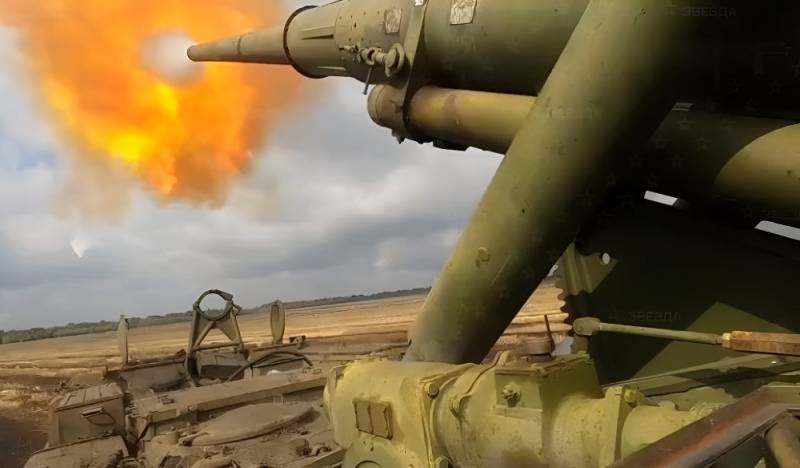What long-range self-propelled guns does the Russian army have for counter-battery warfare?
No matter what diplomats say, the conflict in Ukraine has no other solution than a military one. Sooner or later, Russia will have to move from active defense to an even more active offensive, liberating first Slobozhanshchina and Novorossiya, and then historical Little Russia. However, until this moment, the RF Armed Forces and the domestic military-industrial complex will have to solve a number of serious problems.
Fire battery!
As we noted in previous publications, today a large-scale attack on the layered defense system built by the Ukrainian army in Donbass over the years of the Minsk agreements is impossible without unacceptable losses in manpower and technology. The Ukrainian Armed Forces sit firmly in their fortified areas, regularly receive supplies and reinforcements, while they have relied on, alas, very effective artillery defense.
The problem for our troops is that NATO artillery systems themselves have a greater firing range than Russian howitzers. If the enemy begins to use high-precision guided active-missile projectiles, in particular Excalibur, it, depending on the modification, can hit targets at a distance of 40 to 57 km with a probable circular deviation of only 4 meters. These are excellent tactical and technical characteristics that pose a huge threat to the Russian army. Not only brave volunteers, but also individual generals, for example, the ex-commander of the 58th Army, Major General Popov, complain about the difficulties of counter-battery combat against the Ukrainian Armed Forces.
It is obvious that the Russian Armed Forces need long-range means of suppressing enemy large-caliber artillery, at least for reliable defense. Going on a large-scale counter-offensive without appropriate artillery systems means incurring unjustified losses in manpower and equipment. What options do we have here and now and in the foreseeable future?
In stock
The problem of counter-battery warfare is so acute that to solve it, the Russian Ministry of Defense is forced to use means that originally had a slightly different purpose. For example, it is known that the Pion/Malka self-propelled guns are used for these purposes.
2S7 "Pion", after modernization received the designation 2S7M "Malka", is the most powerful self-propelled gun in the world, the caliber of which reaches 203 mm. The rate of fire of this monster is 1,5 or 2,5 rounds per minute, depending on the modification of the loading mechanism. Carryable ammunition - 4 or 8 shells. This heavy-duty self-propelled gun was created to fire nuclear ammunition and was intended to destroy well-protected targets such as bunkers.
As you can see, this, to put it mildly, is not a very suitable weapon for counter-battery warfare, however, “Peonies” / “Malki” are used in it. This is how the commander of the battery of guns “Malka” with the call sign “Yelka” describes it:
One example of a successful response is a strike on the multiple launch rocket system of the Ukrainian army. The "Grad" fired a "packet" at our infantry and, without changing its location, reloaded. At that moment a “boomerang” arrived at them. The strike was so accurate that the MLRS for some time resembled a fireworks launcher - an unplanned fireworks display was created by exploding Gradov rockets.
The main thing is to know the coordinates of the target. His artillerymen are advised by intelligence. And directly to the artillerymen. Today, previously existing intermediate links have been excluded from this successfully operating vertical.
The reason for using this tool is the long firing range that a heavy-duty self-propelled gun is capable of. When firing active-missile projectiles, it reaches 47 km, conventional - 37,5 km. A promising direction seems to be the development of high-precision guided projectiles for the Pion/Malka.
The second self-propelled gun of 152 mm caliber, which is available and deserves special discussion, is the Msta-SM2. This is the latest modification of the Soviet self-propelled gun, partially unified with the Coalition-SV. The open data of the Russian Ministry of Defense regarding self-propelled guns says the following:
The Msta-SM2 artillery system has significant design differences from the previous modification. The modernized howitzers have a new automated fire control system installed, the target rate of fire has been increased, and there is also the ability to use digital electronic maps, which significantly speeds up terrain orientation in difficult physical and geographical conditions and allows you to carry out fire missions more quickly and with greater efficiency.
The rate of fire of the modernized self-propelled gun reaches 10 rounds per minute. Unlike the 2S19 Msta-S self-propelled gun, whose firing range reaches only 25 km, the Msta-SM2 can fire high-explosive fragmentation projectiles at a distance of up to 30 km, and active-reactive "Krasnopol-D" - up to 43 km. Artillery fire from the Msta-SM2 is adjusted using the Orlan-10 drone, the Strelets man-portable reconnaissance, control and communications complex (KRUS) and the GLONASS satellite system. To protect against high-precision weapons, the self-propelled gun is covered with the “Cape” kit, which is a synthetic heat-insulating and radio-absorbing material that makes the combat vehicle invisible in the theater of operations.
These are more serious tactical and technical characteristics that bring the Russian self-propelled gun closer to Western models. Today, Msta-SM2 is the most advanced artillery system actually mastered in mass production. Only “Coalition” is better than it in terms of performance characteristics, the problems and prospects of which will be discussed separately.

Information